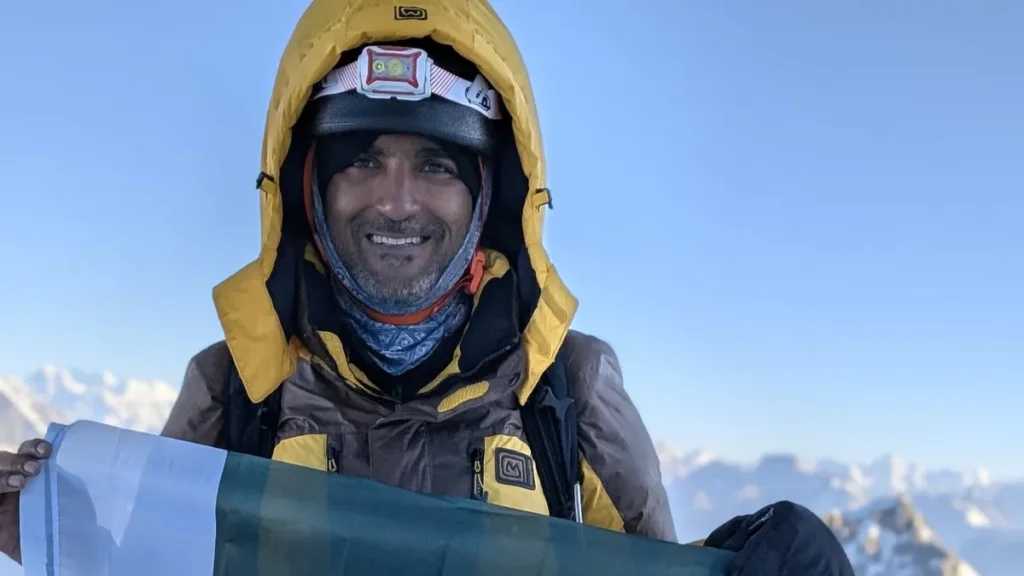This blog article is adapted from the story written by Julia Clarke in Advnture.com.
For Pakistani mountaineer Umer Latif, climbing high-altitude peaks is nothing new. As the founder of an adventure trekking company (Beyond The Valley), but physically based in Lahore, a city that sits a mere 650 feet above sea level, he’s made a career out of guiding people into the rugged beauty of the Karakoram. But this past summer, he decided to take on a unique challenge: could he summit Khosar Gang, a formidable 6,050 meter / 19,850-foot peak, with only three days of acclimatization?
The conventional wisdom? Not a chance.
The reality? He not only summited but did so with energy to spare—thanks to an unexpected training tool: breathwork (yes, the breathwork training we coach at Recal… no surprises here!).

The Challenge: Climbing Fast, Limited Time for Acclimatization
Ordinarily, climbing at extreme altitudes requires time. The CDC recommends at least 11 nights of acclimatization before ascending beyond 18,000 feet. Without proper acclimatization, altitude sickness can derail even the most experienced mountaineers. And yet, Umer didn’t have the luxury of time—his expedition had to fit between two other international treks.
He needed a way to prepare his body for the thin air of Khosar Gang while still training at low altitude. Enter: Recal’s High Altitude Breathwork Training.
A New Approach: High-Altitude Adaptation from Home
Determined to give himself an edge, Umer committed to a five-week High Altitude Breathwork Training program developed by Recal. The program focused on breathing exercises designed to improve his oxygen efficiency, respiratory muscle strength, and, most importantly, his ability to tolerate carbon dioxide (CO2)—a crucial factor for feeling less out-of-breath and maintain proper breathing — a key indicator of altitude endurance performance.
Every day, Umer set aside 15 to 20 minutes to train his breath. Unlike traditional altitude training methods, which might involve hypoxic tents or simulated high-altitude chambers, this approach required nothing more than focused breathing techniques and consistency.
The results? The proof is in the pudding… read on.
The Mountain Test: Did Breathwork Actually Make a Difference?
When Umer finally hit the trail toward Khosar Gang’s summit, he had no illusions—this would be a tough climb. With nearly 5,000 feet of elevation gain and an average slope angle of 29 degrees, his physical endurance would be tested. But the real challenge was altitude itself.
As he ascended, he tracked his blood oxygen saturation levels using his Garmin Epix watch. “What I saw stunned me,” says Latif, as his oxygen saturation was significantly higher than on past climbs. At 5,200 meters (17,000 feet), where many climbers start to struggle, his readings remained around 80-85%—a number that, for someone coming straight from sea level, is almost unheard of.
The impact of breathwork wasn’t just physiological—it was practical. While his guide, a seasoned mountaineer with experience on K2 and Nanga Parbat, fell victim to altitude sickness on day two, Umer pressed forward. He set off for the summit at midnight and reached the top by 6 a.m., just in time to witness one of the most breathtaking sunrises of his life.
But perhaps the most remarkable part? He felt so strong after summiting that instead of resting at base camp, he decided to continue his descent the entire way back to Khaplu, arriving that same evening. In just five days, he’d made it to 6,000 meters and back—all without the typical altitude-related struggles.

Image Courtesy of Advnture.com and Umer Latif
Why Breathwork Worked
The key to success lies in breathwork training’s three distinct areas:
- Improving breathing mechanics for better oxygenation: By optimizing breathing mechanics, climbers can maintain higher oxygen saturation even in hypoxic environments. Our rule of thumb for mechanical efficiency is simple: Nose-Slow-and Low.
- High altitude simulation: using specialized protocols, research shows you can create a hypoxic response in your body to make adaptations, plus build carbon dioxide tolerance. This reduces the urge to hyperventilate, ensuring that oxygen is more efficiently delivered to muscles and organs.
- Strengthening respiratory muscles: Just like any other muscle, the diaphragm intercostals, and abdomen can be trained for endurance and efficiency. This comes in handy, especially when air pressure is lower and oxygen availability is limited at high altitude.
For Umer, these adaptations weren’t theoretical—they were tangible. His ability to maintain composure, avoid breathlessness, and perform at altitude with minimal acclimatization exemplifies just how powerful this kind of training can be.
The Takeaway: Breathwork as a Game-Changer for High-Altitude Climbers
Umer’s story isn’t just a testimonial—it’s a case study in rethinking how we prepare for high-altitude adventures. While breathwork doesn’t replace the need for acclimatization, it offers an additional layer of preparedness for those with time constraints, limited access to high-altitude environments, or inability to purchase expensive hypoxic equipment.
For those looking to push their limits in the mountains, Umer’s experience serves as evidence of effectiveness: training your breath might just be the missing link between struggle and success at altitude.
And as for his next adventure? With breathwork in his arsenal, the sky—quite literally—is the limit.

Image courtesy of Advnture.com and Umer Latif.
Note from Recal:
Umer’s climb is an example of how breathwork training can work. With just five weeks of practice, he summited over 6,000 meters with minimal acclimatization, kept his oxygen levels high, and didn’t experience altitude sickness.
To be clear: we absolutely do not guarantee a particular set of results. But if time is short, you can consider breathwork training as a supplement to your physical training. After all, why not train your breath like you train your body for a high altitude challenge?
Happy training!
Anthony and the Recal Team